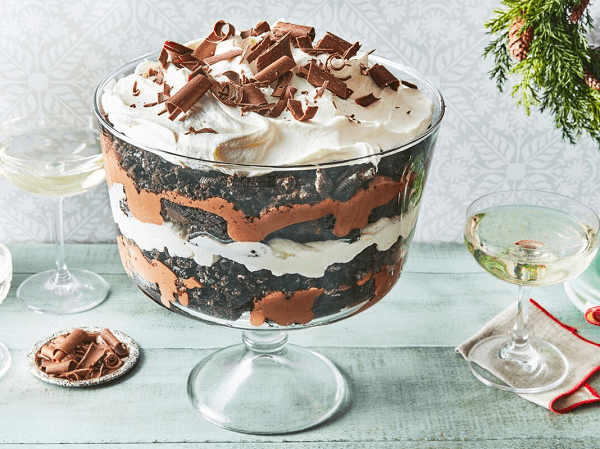Sweets trifle- A trifle is a classic English dessert that typically consists of layers of sponge cake or ladyfingers, custard, fruit, and whipped cream. It’s served in a large bowl or individual glasses, showcasing the beautiful layers. Here’s a basic recipe for a sweet trifle:
Ingredients:
- Sponge cake or ladyfingers
- Custard (you can use store-bought custard or make your own)
- Fresh fruits (berries, sliced strawberries, kiwi, etc.)
- Whipped cream
- Sherry or fruit juice (optional)
- Sliced almonds or grated chocolate for garnish (optional)
Instructions:
- Prepare the Custard:
- You can use instant custard, or make your own by heating milk and combining it with custard powder or egg yolks and sugar. Allow it to cool.
- Prepare the Cake:
- If you’re using sponge cake, cut it into cubes. If you’re using ladyfingers, you can use them whole.
- Layering:
- Start by placing a layer of cake or ladyfingers at the bottom of the trifle dish or individual glasses.
- If desired, you can drizzle a bit of sherry or fruit juice over the cake to add flavor.
- Add Custard:
- Spoon a layer of custard over the cake. Make sure it covers the cake evenly.
- Add Fruits:
- Add a layer of fresh fruits over the custard. You can use a variety of fruits or stick to one type, depending on your preference.
- Repeat Layers:
- Repeat the layers until you fill the trifle dish or glasses. The order is usually cake, custard, fruit, but you can mix it up as you like.
- Top with Whipped Cream:
- Finish the trifle with a generous layer of whipped cream. You can pipe it for a decorative touch.
- Garnish:
- Sprinkle sliced almonds or grated chocolate on top for a finishing touch.
- Chill:
- Refrigerate the trifle for a few hours to allow the flavors to meld and the dessert to set.
- Serve:
- Serve chilled and enjoy your delicious sweet trifle!
Feel free to get creative with the ingredients and make adjustments based on your taste preferences. Trifles are versatile, and you can customize them with different flavors and textures to suit your liking.
What is Sweets trifle
A sweets trifle, or simply a trifle, is a classic English dessert that typically consists of layers of sponge cake or ladyfingers, custard, fruit, and whipped cream. It’s a versatile and visually appealing dessert that’s often served in a large glass bowl or individual glasses, showcasing its layers.
The specific ingredients and variations can vary, but the basic components of a sweets trifle include:
- Sponge Cake or Ladyfingers: The base layer is often made with sponge cake or ladyfingers. These can be soaked in a flavored syrup or sherry for added moisture and flavor.
- Custard: A layer of custard is added on top of the cake layer. Custard is typically made with milk, sugar, and eggs (or custard powder). It adds a creamy and rich texture to the trifle.
- Fruit: Fresh fruits or fruit compote are commonly used in trifles. Berries, sliced strawberries, kiwi, or other fruits are often layered on top of the custard.
- Whipped Cream: A generous layer of whipped cream is added on top of the fruit layer. This adds a light and airy texture to the trifle.
- Optional Extras: Depending on personal preference, you can add extra touches such as nuts, chocolate shavings, or sprinkles on top for garnish.
The beauty of a trifle is its flexibility—you can customize it based on your preferences and the fruits that are in season. Trifles are often made in advance and chilled in the refrigerator, allowing the flavors to meld and the dessert to set before serving.
It’s a delightful dessert that’s perfect for special occasions or any time you want to treat yourself and others to a delicious, visually stunning sweet treat.
Who is Required Sweets trifle
“Sweets trifle” is not a specific person. It seems there might be a misunderstanding. A trifle is a type of dessert, not an individual. As mentioned earlier, a trifle is a classic English dessert made with layers of sponge cake or ladyfingers, custard, fruit, and whipped cream. It’s typically served in a large bowl or individual glasses, showcasing its layers.
If you have a specific question about trifle recipes, preparation, or any related topic, feel free to ask, and I’ll be happy to provide information and assistance!
When is Required Sweets trifle

It seems there’s a bit of confusion. “Sweets trifle” is a type of dessert, not a specific event or time. Trifle is a layered dessert made with ingredients like sponge cake, custard, fruit, and whipped cream. It’s typically enjoyed as a treat or dessert and can be served on various occasions or whenever you have a craving for a delicious and visually appealing sweet dish.
If you have a specific context or event in mind, please provide more details, and I’ll do my best to assist you accordingly.
Where is Required Sweets trifle
“Sweets trifle” is a type of dessert, not a specific location. A trifle is a layered dessert typically made with sponge cake or ladyfingers, custard, fruit, and whipped cream. It’s a popular dessert in the United Kingdom and is enjoyed in various places around the world.
If you’re looking for a place to buy or enjoy sweets trifles, you might want to check with local bakeries, dessert shops, or restaurants that offer a diverse dessert menu. Alternatively, you can make your own trifle at home using a variety of recipes and customize it to your liking.
How is Required Sweets trifle
It seems like you’re asking for information on how to make or prepare a sweets trifle. Making a trifle involves layering different ingredients to create a delicious and visually appealing dessert. Here’s a basic guide on how to make a classic sweets trifle:
Ingredients:
- Sponge cake or ladyfingers
- Custard (store-bought or homemade)
- Fresh fruits (berries, sliced strawberries, kiwi, etc.)
- Whipped cream
- Sherry or fruit juice (optional)
- Sliced almonds or grated chocolate for garnish (optional)
Instructions:
- Prepare the Custard:
- You can use instant custard, or make your own by heating milk and combining it with custard powder or egg yolks and sugar. Allow it to cool.
- Prepare the Cake:
- If you’re using sponge cake, cut it into cubes. If you’re using ladyfingers, you can use them whole.
- Layering:
- Start by placing a layer of cake or ladyfingers at the bottom of the trifle dish or individual glasses.
- If desired, you can drizzle a bit of sherry or fruit juice over the cake to add flavor.
- Add Custard:
- Spoon a layer of custard over the cake. Make sure it covers the cake evenly.
- Add Fruits:
- Add a layer of fresh fruits over the custard. You can use a variety of fruits or stick to one type, depending on your preference.
- Repeat Layers:
- Repeat the layers until you fill the trifle dish or glasses. The order is usually cake, custard, fruit, but you can mix it up as you like.
- Top with Whipped Cream:
- Finish the trifle with a generous layer of whipped cream. You can pipe it for a decorative touch.
- Garnish:
- Sprinkle sliced almonds or grated chocolate on top for a finishing touch.
- Chill:
- Refrigerate the trifle for a few hours to allow the flavors to meld and the dessert to set.
- Serve:
- Serve chilled and enjoy your delicious sweet trifle!
Feel free to get creative with the ingredients and make adjustments based on your taste preferences. Trifles are versatile, and you can customize them with different flavors and textures to suit your liking.
Case Study on Sweets trifle
Title: The Timeless Allure of Sweets Trifle: A Delectable Journey Through Layers of Delight
Introduction:
- Brief overview of trifle as a dessert.
- Introduction to the popularity and versatility of sweets trifle.
Historical Background:
- Explore the historical roots of trifle, dating back to its origins in England.
- Evolution of the dessert over time and its adaptation in different cultures.
Cultural Significance:
- Discuss how trifle is a part of cultural celebrations and festive occasions.
- Explore how different regions or countries incorporate trifle into their culinary traditions.
Ingredients and Variations:
- Breakdown of the essential components of a sweets trifle: sponge cake, custard, fruit, and whipped cream.
- Showcase popular variations and creative adaptations of trifle recipes around the world.
Notable Trifle Creations:
- Highlight famous or innovative trifle creations by renowned chefs or restaurants.
- Discuss any unique or unconventional ingredients used in these notable trifles.
DIY Trifle Experience:
- Provide a step-by-step guide on how to make a classic sweets trifle at home.
- Encourage readers to experiment with flavors and textures, showcasing the versatility of trifle.
Modern Trends:
- Discuss how trifle has adapted to modern culinary trends, including variations for dietary preferences (e.g., vegan or gluten-free trifle).
- Explore the influence of social media on the presentation and popularity of sweets trifles.
Consumer Experience:
- Gather feedback and experiences from individuals who have made or enjoyed sweets trifle.
- Showcase the emotional and sensory aspects of indulging in this layered dessert.
Conclusion:
- Summarize the enduring appeal of sweets trifle.
- Emphasize its versatility, cultural significance, and ability to bring joy through a delightful culinary experience.
References:
- Cite historical sources, culinary references, and expert opinions to support the information presented.
Remember, this is just an outline, and you can expand on each section with detailed information, case studies, interviews, or any relevant data you may find during your research.
White paper on Sweets trifle
Title: Exploring the Delightful Layers of Sweets Trifle
Abstract: This white paper delves into the world of sweets trifle, a beloved and versatile dessert with a rich history and cultural significance. From its origins in England to its contemporary variations, this paper explores the key elements, culinary trends, and the enduring appeal of sweets trifle.
1. Introduction:
- Brief overview of the importance of desserts in culinary culture.
- Introduction to the focus on sweets trifle and its popularity.
2. Historical Evolution:
- Tracing the roots of trifle back to its inception in 16th-century England.
- Examining the dessert’s evolution over the centuries and its adaptation in different cultures.
3. Components and Culinary Craft:
- In-depth analysis of the essential components – sponge cake, custard, fruit, and whipped cream.
- Exploring the craftsmanship involved in layering and presenting a perfect trifle.
4. Cultural Significance:
- Discussing how trifle is woven into the fabric of cultural celebrations.
- Analyzing regional variations and the role of trifle in festive occasions.
5. Culinary Creativity:
- Showcasing the diversity of trifle recipes worldwide, from classic to contemporary.
- Highlighting innovative creations by chefs and establishments pushing the boundaries of trifle.
6. DIY Experience:
- Providing a step-by-step guide for enthusiasts to create their own trifle at home.
- Encouraging experimentation with flavors, textures, and unique ingredients.
7. Modern Trends:
- Investigating how trifle has adapted to meet modern culinary trends.
- Exploring the influence of social media on the presentation and popularity of sweets trifle.
8. Nutritional Considerations:
- Examining the nutritional content of traditional trifle ingredients.
- Exploring variations for dietary preferences such as vegan, gluten-free, or low-sugar trifle.
9. Consumer Insights:
- Gathering feedback and experiences from individuals who have made or enjoyed sweets trifle.
- Analyzing consumer preferences and trends in trifle consumption.
10. Future Prospects:
- Speculating on the future of sweets trifle in the culinary landscape.
- Identifying potential innovations and trends that may shape the evolution of trifle.
11. Conclusion:
- Summarizing the key findings and insights gained from the exploration of sweets trifle.
- Reiterating the enduring popularity and adaptability of this layered dessert.
12. References:
- Citing historical sources, culinary references, and expert opinions to support the information presented in the white paper.
This comprehensive white paper aims to provide a thorough understanding of sweets trifle, offering valuable insights for culinary enthusiasts, professionals, and those curious about the world of desserts.
Industrial Application of Sweets trifle
While sweets trifle is traditionally viewed as a delightful homemade dessert, there may be industrial applications in the food and hospitality industry. Here are a few potential industrial applications of sweets trifle:
- Food Service and Catering:
- Trifles can be produced on a larger scale to serve at events, catering functions, or in restaurants. Industrial kitchens can streamline the production process, allowing for efficient preparation of large quantities.
- Frozen Dessert Production:
- Industrial food manufacturers might create frozen versions of sweets trifle for retail or food service. These could be sold in grocery stores or offered as a convenient frozen dessert option in restaurants and cafes.
- Ready-to-Eat Desserts:
- Companies specializing in pre-packaged desserts could produce single-serve portions of sweets trifle. These could be sold in supermarkets or as part of ready-to-eat meal solutions.
- Dessert Mixes and Kits:
- Industrial food manufacturers might develop dessert kits or mixes that allow consumers to assemble their own trifle easily at home. This could include pre-packaged cake cubes, custard mix, and fruit toppings.
- Incorporation into Other Products:
- The flavors and concept of sweets trifle could be incorporated into other food products, such as ice cream, yogurt, or snack bars. This allows for the diversification of product lines based on the popularity of trifle flavors.
- Hospitality and Airlines:
- Large-scale production of individual trifle servings could be suitable for use in the hospitality industry, such as hotels, resorts, and airlines, where pre-packaged desserts with a longer shelf life may be preferred.
- Customizable Dessert Bars:
- In foodservice settings like buffets or dessert bars, an industrial approach could involve offering a build-your-own trifle station. Pre-prepared components could be provided, and customers can assemble their personalized trifles.
- School and Institutional Cafeterias:
- Industrial-scale production of sweets trifles may be applicable to school cafeterias or institutional settings where there’s a need for large quantities of consistent, visually appealing desserts.
It’s important to note that while industrial applications can increase efficiency and scalability, maintaining the quality and taste of a homemade trifle may pose challenges. Balancing convenience with maintaining the essence of a well-crafted trifle is a key consideration in these applications. Additionally, adherence to food safety and quality standards is paramount in any industrial food production setting.





